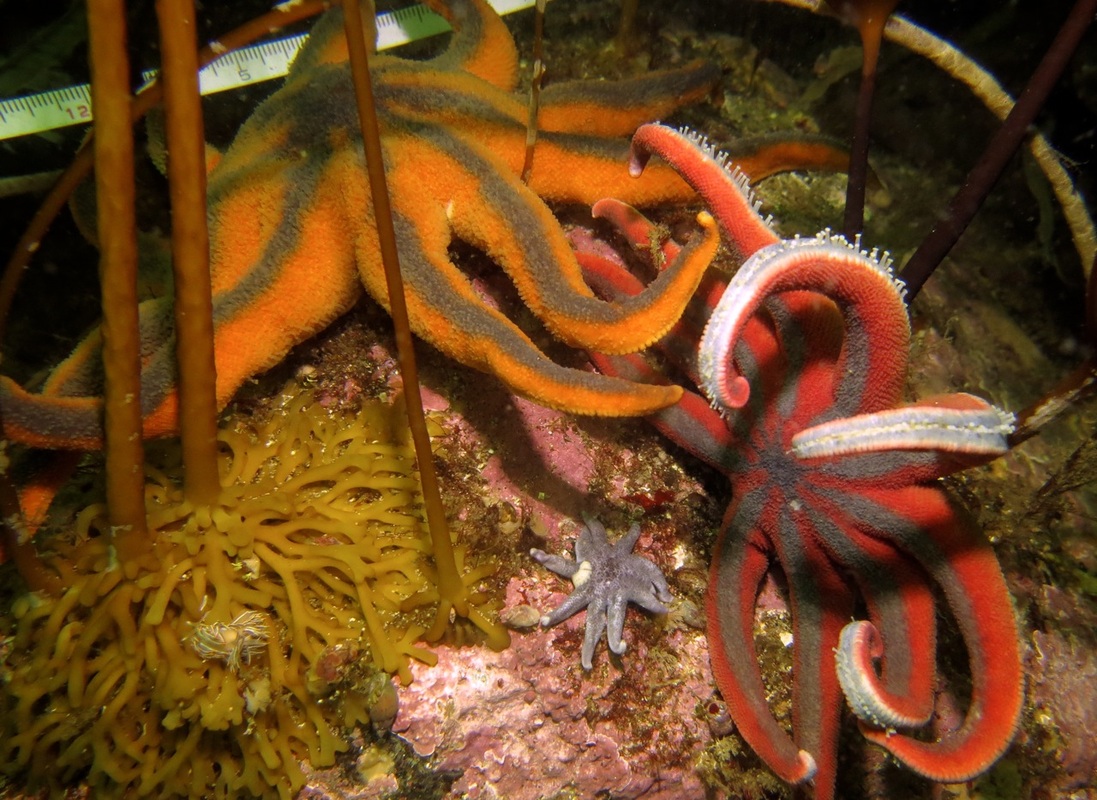Striped sunstar, Stimpson's sunstar • Solaster stimpsoni
{Sol = sun, aster = star; stimpsoni = after William Stimpson, a naturalist at the Smithsonian Institution in the 1800's}
Identification
This large sea star gets to 50 cm across and usually has 10 rays (arms may vary from 9 to 12). Its long and slender rays are tapered and each is marked by a dark purplish-blue stripe. These stripes radiate out from the central disc and contrast against the rest of the sea star, which is usually orange, red, or pink (photos). Occasionally the whole animal is blue, however in such cases the darker radiating stripes may still be visible.
Habitat & Range
The striped sunstar is most commonly found in rocky locations, though it does inhabit sandy-muddy areas as well. It lives in the intertidal and subtidal to a depth of about 200 m. It is a common species, with a range extending from northern Alaska to Oregon; some sources extend its range south to central California, where it may be less common than further northward. It is found in Japan as well.
Similar Species
The dark radiating stripes and long narrow rays help distinguish the striped sunstar from similar species, such as the northern sun star (Solaster endeca) which sometimes has stripes but on markedly shorter rays, the orange sunstar (S. paxillatus) which has broader, shorter rays and no stripes, and the morning sunstar (S. dawsoni)
Intriguing Info
This species is preyed upon by the morning sunstar.
This large sea star gets to 50 cm across and usually has 10 rays (arms may vary from 9 to 12). Its long and slender rays are tapered and each is marked by a dark purplish-blue stripe. These stripes radiate out from the central disc and contrast against the rest of the sea star, which is usually orange, red, or pink (photos). Occasionally the whole animal is blue, however in such cases the darker radiating stripes may still be visible.
Habitat & Range
The striped sunstar is most commonly found in rocky locations, though it does inhabit sandy-muddy areas as well. It lives in the intertidal and subtidal to a depth of about 200 m. It is a common species, with a range extending from northern Alaska to Oregon; some sources extend its range south to central California, where it may be less common than further northward. It is found in Japan as well.
Similar Species
The dark radiating stripes and long narrow rays help distinguish the striped sunstar from similar species, such as the northern sun star (Solaster endeca) which sometimes has stripes but on markedly shorter rays, the orange sunstar (S. paxillatus) which has broader, shorter rays and no stripes, and the morning sunstar (S. dawsoni)
Intriguing Info
This species is preyed upon by the morning sunstar.
References
Adams, M. J. (2005). Solaster stimpsoni (Striped sunstar). Beach Watchers. Washington State University. Accessed 13/02/2015.
Cowles, D. (2005). Solaster stimpsoni Verrill, 1880. Invertebrates of the Salish Sea. Rosario Beach Marine Laboratory. Accessed 13/02/2015.
Harbo, R. M. (2011). Whelks to whales: Coastal marine life of the Pacific Northwest [revised]. Madeira Park, BC: Harbour Publishing. P. 174.
Lamb, A., and Hanby, B. (2005). Marine Life of the Pacific Northwest [electronic version]. Madeira Park, BC: Harbour Publishing.
Lambert, P. Solaster stimpsoni Verrill, 1880. In Klinkenberg, Brian. (Ed.) E-Fauna BC: Electronic Atlas of the Fauna of British Columbia. Lab for Advanced Spatial Analysis, Department of Geography, University of British Columbia, Vancouver. Accessed 13/02/2015.
Authors and editors
Kelly Fretwell and Brian Starzomski (2014).
Adams, M. J. (2005). Solaster stimpsoni (Striped sunstar). Beach Watchers. Washington State University. Accessed 13/02/2015.
Cowles, D. (2005). Solaster stimpsoni Verrill, 1880. Invertebrates of the Salish Sea. Rosario Beach Marine Laboratory. Accessed 13/02/2015.
Harbo, R. M. (2011). Whelks to whales: Coastal marine life of the Pacific Northwest [revised]. Madeira Park, BC: Harbour Publishing. P. 174.
Lamb, A., and Hanby, B. (2005). Marine Life of the Pacific Northwest [electronic version]. Madeira Park, BC: Harbour Publishing.
Lambert, P. Solaster stimpsoni Verrill, 1880. In Klinkenberg, Brian. (Ed.) E-Fauna BC: Electronic Atlas of the Fauna of British Columbia. Lab for Advanced Spatial Analysis, Department of Geography, University of British Columbia, Vancouver. Accessed 13/02/2015.
Authors and editors
Kelly Fretwell and Brian Starzomski (2014).




